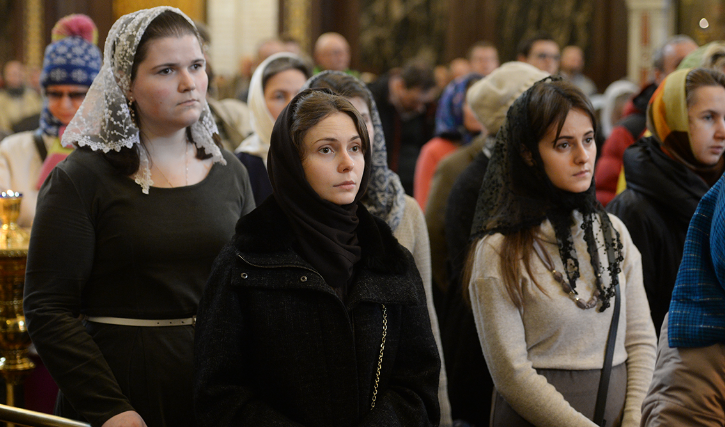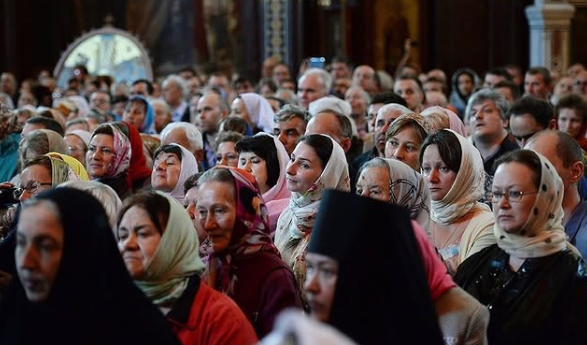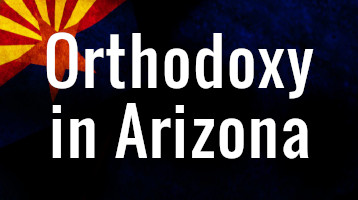
by His Grace, the Right Reverend Alexei, Bishop of Sitka and Alaska
Humility, chastity, and modesty are virtues that especially adorn the most Pure Virgin Mother of our God. Modesty is itself one of the fruits of the Spirit enumerated by Saint Paul. Modesty is a kindness towards one’s neighbor, a humble goodness that provokes neither envy nor desire, and love that thinks more of others than of self. When we pray in Church, we are especially called to modesty, which enables us to approach God with that humble and contrite heart that He will not despise. Our Lord Himself was modest, modest about His miracles, modest in His speech, modest in His example, modest in the washing His disciples’ feet.
Head-coverings are meant to help women cultivate modesty, humility, and love for their brethren during prayer. Early Christian writers viewed the veil or head-covering as a spiritual armor protecting women not only from the gaze of men, but also as a defense against scandal, suspicion, and envy. They were also seen as expressions of obedience, which is why monastics who are men are also required to wear a veil in the Church. Thus, the head-covering is a visible way of saying,
“Behold the handmaid of the Lord; be it unto me according to thy word.”
In the Orthodox Church, the act of placing something under or behind a veil sets it apart as special, as something to be revered and respected, similar to the role played by the temple veil of the Holy of Holies in Jerusalem. Thus, there is a connection between a woman’s veil with covering and revering that which is precious, such as the chalice that contains the wine that will become the Most-pure blood of Christ. And those coverings themselves also become holy. We can see this in the account of the Byzantine Empress Eudokia who donated her personal veil/head-covering to a monastery for use as an altar cloth. Of all articles of clothing, only a woman’s head-covering could become a vestment for the holy altar, for it is already a kind of vestment.
One of the special blessings for Orthodox Christian women is the privilege to follow in the footsteps of saintly women and the Mother of our God in wearing headcoverings as they did in a spirit of modesty and purity. In the Old Testament, we find Rebecca and Susanna putting on or already wearing head-coverings or veils in a spirit of modesty and purity, a practise that would be praised by the church fathers. The most-virgin Mother of God followed this practice and our Lord’s Apostles encouraged it among god-loving women. In fact, Saint Paul, who maintained that Christians are not required to follow Jewish dietary laws, did insist on the importance of continuing to follow the holy tradition of women covering their heads at prayer.
And so, women would wear head-coverings in Church in humble, loving obedience to the counsel of Saint Paul who asked the faithful to
“keep the traditions just as I delivered them to you.”
He then writes,
“Every man praying or prophesying, having his head covered, dishonors his head. Every woman who prays or prophesies with her head uncovered dishonors her head.”
He also noted that women ought to have their heads covered
“because of the angels,”
whose entire holy existence is one of obedience, order, and attention to the will of God. For nearly 2,000 years, women accepted this word of Saint Paul with simplicity and made it a beautiful part of their spiritual lives. Bishops, priests, deacons, and monks were not the only ones to have special clothing for Church.
Every Orthodox woman has that privilege as well. Until the fifties, the practice of wearing a head covering in Church was practiced in every Christian community. Roman Catholic and Protestant women alike would always wear a head-covering when going to Church to pray, honoring the Word of God and the practice of their mothers and grandmothers.
Society in the 50s and 60s, however, changed greatly. The sexual revolution, the war on motherhood, an attack on the feminine, a mentality centered on rights and victimhood, rather than virtue and responsibility, drastically altered the way people looked at every aspect of human life. Those who maintained traditional values and customs would come to be ridiculed. Childbearing would be seen as an inconvenience. Marriage would be seen as a hindrance. And modesty would even be seen as oppression. And so, non-Orthodox Christian communities began to view the Apostle Paul’s fatherly guidance about head-covering very differently.
In the Holy Orthodox Church, the wearing of head scarves or veils still remains a revered tradition. In addition to Scripture, many holy fathers and mothers also advocated this practice. In the 2nd century, Saint Hippolytus of Rome wrote in the Apostolic Traditions,
“Let all women have their heads covered with an opaque cloth.”
Saint John Chrysostom also encouraged women to wear their head-coverings or veils
“with care and diligence,” mentioning that as we “wash our hands when we wish to pick up the Bible,… [so] a woman, if she is unveiled, immediately puts on a covering, displaying a token of her inner piety. Do you see that the outward appearance proclaims the inner piety?”
In other words, it is an outward expression of love for God and a sense of awe in His presence, which is the patristic definition of piety.
Furthermore, nearly every woman Saint whose icons adorns the frescoes of Orthodox Churches is wearing a headscarf or veil. The only exception is Saint Mary of Egypt, but that is in keeping with the practice in the ancient world for prostitutes to go without head-coverings to be more attractive to men, but for married women to wear a covering on their heads out of modesty. That is also why the woman with many sins who wiped the Lord’s feet with her hair was without such a covering.
In the Lives of the Saints, the wearing of veils is associated with an overshadowing of grace. Scenes of women martyrdoms often depict women without their veil to show that they are suffering violence. Saint Ioannikios healed a woman possessed by the demon of fornication by placing a veil on her head. In the life of the converted prostitute, Saint Pelagia, the writer notes that her wearing a head-covering was a sign of her conversion. But most importantly, all Orthodox Christians celebrate the protecting veil (pokrov) of the Mother of God every year. The inhabitants and visitors to Constantinople could venerate that head-covering of the all-pure Virgin Mary and through it ask for her protection. This is the one covering that all Orthodox Christians, men and women, desire to be under and protected by. Every Orthodox woman who wears a veil or head-covering is also blessed by that veil of the Mother of God, which miraculously and repeatedly protected the faithful from so much harm.
Of course, wearing a head-covering is a personal decision that a woman must make after prayer and consideration. Sarah Elizabeth Cowie was a pro-choice feminist who found her way into the Orthodox Church and embraced Holy Tradition. In her book, More Spirited than Lions, she explores this subject, laying bare the objections to this blessed practice and the benefits of adopting it as well:
What could be the reasons for abandoning a 2,000 year-old tradition that the Holy Apostle thought right and good? If we say it is sexist or old fashioned, we choose worldliness over godliness. If we say the practice was tied to customs of the ancient world that are no longer in place, we side with modernity and deny the validity of Tradition in the Church. If we say even many Catholics have abandoned the practice, that no other churches require it, and that we don’t want to be different, we are siding with the traditions of men over the traditions of God. If we say we do not look good in hats or they flatten down our hair, making us look ridiculous when we take them off, we give in to vanity and pride. If we say the practice is inconvenient, or we simply do not like it, we give in to sloth. What a wonderful opportunity for unseen warfare! What a wonderful opportunity to develop virtue! Here by such a simple act as covering our heads, we can wage battle against worldliness, vanity, pride, and sloth. The women saints lived lives of true asceticism which most of us are far too weak, and worldly to imitate. Can we not at least do something as simple as covering our heads in church out of love for Christ.
The external things that the Church requires us to do, as women, are small things. And yet, even these small maters are difficult for us, being raised in the climate of these modern times, which caters to our egos and personal desires. We want to submit only when we want to and only to what seems reasonable to us— which, of course, is not true submission at all…. “Another consideration comes from the Holy Fathers who tell us that for the beginner (which is usually interpreted as all of us), the state of the soul conforms to that of the body. Part of the reason why we need modest dress and a reverent posture in church is that this helps us
“lay aside all earthly care”
and
“mystically represent the cherubim.”
If there was ever a generation which needed the sacred Tradition of the Church to help us out of our worldly mentality and into the otherworldly presence of God, it’s us.
Finally, there is another, deeper, and mystical significance to covering the head. Saint Paul writes,
“For this cause ought the woman to have power on her head because of the angels.”
Saint John Chrysostom in commenting on this writes,
“ a sign of authority,” instead of “power.”
Many women notice that when they cover their heads, it contributes to sobriety, prayerfulness, and guarding the tongue. Somehow, binding the head helps bind our senses, helps gird our loins for the buisiness of prayer and worship; it aids us in the task of crying out to the Lord from the depths of our heart.
A head covering is not just an exterior custom; it has meaning for the soul. This is the case with everything connected with Church Tradition. It is Tradition because it is full of meaning. Tradition helps the soul on its heavenward journey.




